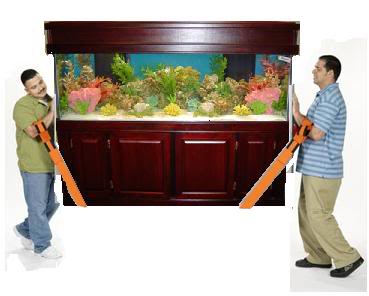How to move an aquarium
You may need to move your fish tank/aquarium in some situations, say when relocating. Moving your aquarium can be a tedious task, but with a little planning, the correct handling, and the proper supplies, your fish should make it to their new home with minimal upset. The following guidelines enable you to walk through the process mentally, alerting you to any precautions you need to take to help ensure a smooth transition.
Moving Fish
In a case where you are relocating within your home, net your fish into a clean, 5-gallon bucket with plenty of aquarium water. Carefully scoop out invertebrates in a small, clean plastic container before placing them in the bucket.
On the other hand, when moving less than one hour from your home, bag your specimens individually the same way your pet store does. Once bagged, keep the fish in the dark to reduce stress.
Finally, if moving a distance of 1-6 hours away, again bag the fish individually. But this time, you’ll need to add pure oxygen to the bags, supplied by your local fish store. Always ensure you call ahead of time to check for availability, and agree upon a time. Live plants can be transported in bags, too, with some of the original aquarium water. Wrap leaves in wet newspaper to prevent drying out, or make sure plants are completely submerged. Maintain water temperature for your fish and other specimens by placing them, in their sealed bags, within a sealed cooler.
How to Move an Aquarium – Preparation
• Discontinue feeding your fish two days before the move
• Establish a checklist of items you’ll need at your new destination, such as pre-mixed saltwater or an ammonia-removing product
• Acquire several clean 5-gallon buckets that have not housed chemicals or detergents
• Designate a space in the moving truck closest to a door for easy access to your aquarium and equipment
• Your aquarium should be the last thing you pack, and the first thing you take out and set up
• Move your fish separately from the aquarium
Moving the Aquarium
When taking down the aquarium, save as much of the water as you can. Use 5-gallon buckets with lids to transport water. Reusing your water cuts the cycling time considerably once you restart the system, and decreases the likelihood of a toxic ammonia spike. Pack your pumps, heaters, and other equipment the way you would pack fragile appliances.
Remove the gravel and water and place in 5-gallon buckets to alleviate the stress on the aquarium seams resulting from the bumps and bouncing during transport. Keep your filter media and sponges immersed in some of your aquarium water, as well, to minimize disruption of the bacteria colonies within them. This, too, helps reduce cycling time.
For moves further than 6 hours, take out your gravel or substrate and bag it with some aquarium water. Either clean or discard your filter media, but if you do this please remember that your system will have to be treated as new when starting it up again. This necessitates a complete cycling, and only a few hardy species of fish will be able to withstand the cycling process. You should make temporary arrangements for your other fish until the aquarium has been properly cycled.
When moving the aquarium within your home, use the buckets as mentioned above. Leave enough water in the aquarium to fully cover the gravel. There’s no need to pack your pumps and other equipment, but it is a good idea to keep submersible filters in a container with some aquarium water.
How To move an Aquarium- On Arrival
Whether your new destination is within your existing home, or a new location altogether, you’ll need to work quickly to get your aquarium operating again. Fill it with as much of the old water as you were able to save. Top off with fresh water or premixed saltwater, get your filters, heaters, and other equipment running, and then add a bacterial additive to accelerate cycling. Add your plants and decorations and test your water parameters. If acceptable, add your livestock after proper acclimation.
Hopefully you have a better understanding of how to move an aquarium.






